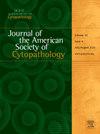超声内镜引导下细针穿刺和细针活检在胃肠道淋巴瘤诊断中的应用。
Q2 Medicine
Journal of the American Society of Cytopathology
Pub Date : 2025-03-01
DOI:10.1016/j.jasc.2024.12.002
引用次数: 0
摘要
超声内镜引导下细针穿刺活检(EUS-FNA/B)在胃肠道淋巴瘤临床治疗中的作用尚未得到广泛研究。本研究在一家大型学术机构调查了EUS-FNA/B在首次和复发性胃肠道淋巴瘤诊断中的应用。材料与方法:本研究共纳入40例经EUS-FNA/B行世界卫生组织(who)造血淋巴组织肿瘤分类最终诊断为淋巴瘤的患者。排除同时使用产钳进行粘膜活检或临床随访失败的病例。通过EUS-FNA/B诊断与最终诊断的比较,探讨EUS-FNA/B诊断的准确性及临床应用。结果:EUS-FNA/B诊断与WHO最终诊断的符合率高达72.5%。在剩余的27.5%中,17.5%的细胞学特征足以诊断淋巴瘤,表型不完整,而剩余的10.0%显示可疑淋巴瘤的特征。细胞阻滞和流式细胞术质量显著影响诊断准确性。在FNA期间,1 ~ 5次的次数比6次或更多的次数产生更好的诊断准确性;然而,在单独使用FNB或联合使用FNA的过程中,没有发现差异。由细胞病理学家或细胞技术专家进行EUS-FNA的现场充分性诊断性能无显著差异。结论:EUS-FNA/B联合免疫细胞阻滞和流式细胞术等辅助研究有助于胃肠道淋巴瘤的有效首次诊断和复发诊断。本文章由计算机程序翻译,如有差异,请以英文原文为准。
Endoscopic ultrasound-guided fine-needle aspiration and fine-needle biopsy in the diagnosis of gastrointestinal lymphomas
Introduction
The role of endoscopic ultrasound-guided fine-needle aspiration and fine-needle biopsy (EUS-FNA/B) in the clinical management of gastrointestinal lymphoma has not been extensively studied. This study investigates the use of EUS-FNA/B in the diagnosis of first-time and recurrent gastrointestinal lymphomas at a large academic institution.
Materials and methods
A total of 40 patients who had final diagnosis of lymphoma according to the World Health Organization (WHO) classification of tumors of hematopoietic lymphoid tissues who underwent EUS-FNA/B were included in the study. Cases with concurrent forceps mucosal biopsies or lost to clinical follow-up were excluded. The diagnostic accuracy and clinical use of EUS-FNA/B was investigated by comparing EUS-FNA/B diagnosis with the final diagnosis.
Results
EUS-FNA/B diagnoses were concordant with the final WHO diagnosis for as high as 72.5% of the cases. Of the remaining 27.5%, 17.5% had enough cytologic features for lymphoma diagnosis with incomplete phenotyping, while the remaining 10.0% showed features suspicious for lymphoma. Cell block and flow cytometry quality significantly affected diagnostic accuracy. Number of passes between 1 and 5 yielded better diagnostic accuracy than 6 or more passes during FNA; however, no difference was identified during procedures that used FNB alone or combined with FNA. There is no significant difference in onsite adequacy diagnostic performance of EUS-FNA performed by cytopathologists or cytotechnologists.
Conclusions
EUS-FNA/B with concurrent ancillary studies such as immunocytochemistry in cell block and flow cytometry can be helpful in efficient first and recurrent diagnoses of gastrointestinal lymphomas.
求助全文
通过发布文献求助,成功后即可免费获取论文全文。
去求助
来源期刊

Journal of the American Society of Cytopathology
Medicine-Pathology and Forensic Medicine
CiteScore
4.30
自引率
0.00%
发文量
226
审稿时长
40 days
 求助内容:
求助内容: 应助结果提醒方式:
应助结果提醒方式:


